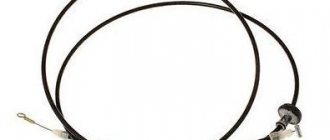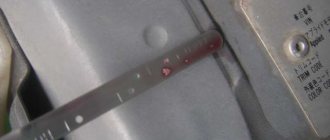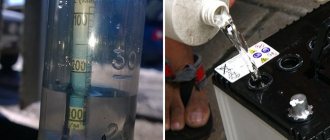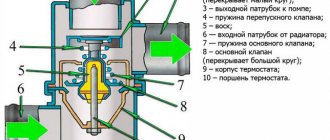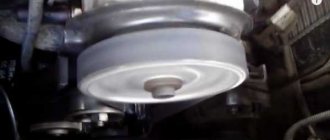We confirm the malfunction
Before you begin troubleshooting, you should make sure that the failure to print is due to the specified operating system service. To check its condition, let's find it among the other components in the list. To do this you need to follow a few simple steps.
- Open the quick command window using the combination Windows + R.
- Enter the command “services.msc”.
- We are waiting for the list of services to open.
- Find “Print Spooler” in the list and double-click on it.
Now you need to make sure that it is stopped and not running. We look at the corresponding labels in the properties window, as shown in the figure below. If necessary, we change to the required ones and forcefully launch them to “revive” the operation of the printers. Change the startup type to “Automatic” and click on the “Run” button, and then “Apply” and “OK”.
There is no print service in the list of services
There are times when we may not find the printing service we need in a long list. Then you can search for “Printers Spooler” if you are using the English interface of Windows OS. Even if nothing is found, the situation is quite problematic. This means that the user (you or someone else) accidentally or without knowing it deleted important files in the system folders on the Windows drive. Another reason for the disappearance of the print manager may be the presence of malware, or simply viruses, on the PC. The solution could be:
- Check the system registry, namely the value of the DependOnService parameter in the HKEY_LOCAL_MACHINE/SYSTEM/CurrentControlSet/Services/Spooler branch. It should be equal to "RPCSS http". Change if inconsistent. You can enter the editor through quick launch (Windows + R) and the “regedit” command.
- Cleaning your computer from viruses with a full-fledged antivirus or a one-time free utility.
- Return to a restore point, if one was created.
- Complete system reinstallation.
Is it possible to reinstall it
The answer to this question is no, this feature is not provided in Windows. All you can do is stop the Device Manager service, clear the document queue, and remove the printer and drivers related to it. The service itself cannot be removed.
So, problems may arise with the print manager in Windows 7, due to which it will turn off, not start, freeze, or load the processor. All these errors can be resolved manually by following the instructions above. Perhaps the solution to the problem can be described on the official website of your printer manufacturer.
Source
Causes of problems with the dispatcher
To understand further manipulations on the computer, you should highlight the reasons why the print service may stop.
- Malicious software negatively affects the operation or attempts to start various services, which leads to problems with the operation of the printer.
- Some critical system files have been deleted by the user or by viruses.
- The drivers that are responsible for the correct operation of the printer are outdated. Or they are incompatible with the latest Windows update and cause a conflict.
- The service is down due to problems with other services that the print spooler directly depends on.
All ways to start the Print Spooler service if it stops
The main reason for a printer’s refusal to work for its intended purpose is the unauthorized shutdown of the print spooler service. Such a nuisance can occur in any version of Windows XP, 7, 8.1, 10. The main task of the user in such a situation is to find a solution to turn it back on. A separate problem is a malfunction when the service does not start with the message “Failed to start on the local computer.”
In this instruction we will explain with examples why the “Spooler” is turned off. Let's consider solutions by rebooting the personal computer, setting up the service to start, checking the system for malware, fixing it using the built-in tools of Windows itself, reinstalling the entire driver package and the printer itself. All this is guaranteed to help restart printing again.
Ways to fix the problem
Reboot PC
If the disappearance of the list of printers from the “Print” menu of various programs that allow this action is infrequent, then restarting your personal computer or laptop can help with the problem. But if the same incidents happen again in the future, then this solution option is clearly not suitable in such a situation.
Launch setup
The first step is to double-check the settings of the service and those on which it depends. Following the instructions described in the very first paragraph of the article, go to the service properties. On the “General” tab, in the “Startup Type” section, select “Automatic” without “Delayed Start”. “Status” is changed to “Working” if it is different at the moment. Use the “Run” button. Don't forget to apply and save the settings. The bookmark should look like this.
Go to the “Dependencies” tab and look at what services are listed there. Their operation and settings also need to be double-checked and, if necessary, configured correctly. Remote Procedure Call (RPC) can easily be found in the same list in the Services window.
It would be a good idea to configure the behavior of the service in case of failures. This is done on the “Recovery” tab. We set the “Restart” mode for the first and second failure.
Virus check and system scan
As has already been mentioned many times, the problem is often the presence of malicious software on the PC, or popularly known as “viruses”. To remove this reason from the list of possible causes, you need to perform a deep scan of the system and remove malicious files. For such purposes, you can use a standard, previously installed antivirus with fresh databases. If this is not the case or updating to the latest version is problematic, then use any free one-time scanner. An excellent option for such purposes is Cureit from. It is recommended to download from the company's official website.
After scanning, treating damaged files and removing malicious ones, experts recommend checking the integrity of Windows itself. In this case, you should use the built-in utility “sfc”, which can do everything itself without user intervention or settings on his part. The procedure is as follows:
- Open the launch window using the Windows + R keys.
- Enter the command "cmd" to launch the command prompt.
- In it, run “sfc /scannow”.
- Be patient and wait for the process to complete.
- When finished, restart your computer.
Correction using Windows
As another simple and quick option, you can consider correcting the situation using the built-in tools of the operating system itself. To do this, through the control panel, go to the “Troubleshooting” section, and in it select “Hardware and Sound”. In the list that opens, find the “Printer” shortcut.
If you use several printing devices, the system will prompt you to select the problematic one. Then we follow the wizard’s instructions and the utility’s prompts. Simple problems will be fixed without your direct participation. But automatic corrections may not always be enough for a positive result.
Clearing the print queue
Often, a large number of tasks sent to the printer may hang. This creates a queue that interferes with the normal operation of printing devices. All the user needs to do is clear this queue. This procedure can be done in several ways.
- Clearing the temporary folder.
- Command line.
- Special Bat file.
- Third party utilities.
To perform the first method, you need to find the folder “C:\Windows\system32\spool\PRINTERS” on the system drive, and most likely it is “C:/” and delete everything that is there. This will clear the print queue as quickly as possible. Files may not be deleted if the print service is running. You need to stop it for the duration of cleaning, and then turn it back on.
All ways to remove documents from the queue. Detailed description of the steps for each cleaning option.
Reinstalling the driver
Drivers can affect the Print Spooler service for many reasons.
- The installed “firewood” from the installation disk is intended for earlier versions of Windows.
- You have updated your operating system to the latest version, which conflicts with the printer software.
- Files are damaged by users or malware.
The only solution in this situation is to reinstall the driver. It is critical that these are the latest drivers for your printing device model. Of course, you can and should only download them from the official website of the printer manufacturer.
Detailed instructions for installing the printer driver. Links to download the latest software versions for different brands.
It is important to correctly and completely remove old drivers before installing new versions so that not the slightest trace of them remains in the system. To do this you need:
- Uninstall the device itself in the “Devices and Printers” section of the control panel. To enter this section, use special commands. First Windows + R, and then “control printers”. Select the desired model and use the right mouse button to “Delete”.
- Remove the driver package via the print server.
We start the server, and on the “Driver” tab we remove the required package.
In some cases, you may need to stop the print service if it is running. - If necessary, clean the registry or use special utilities.
Other options to remove the printer driver from the operating system Description of each step to completely remove the device software.
Collection of fresh drivers Download from direct links.
Installing a printer via a local port
In some cases, installing printing equipment through a local one helps with problems with the print manager. Try this by following these steps:
- Open the printers section through the control panel.
- There, in the menu at the top, select “Install”.
- In the window, click on the first option “Add local”.
- Next, “Create a new port” and select “Local Port” from the list.
- Specify any port value.
- Next, follow the instructions of the installation wizard.
What to do if the spooler is heavily loading the processor
Many users of different versions of Windows often complain that the “spooler” process heavily loads the processor. The problem becomes more acute when utilization starts to reach the 80 percent mark. This is truly an atypical situation and such loading should not happen. Let's consider the possible causes and their quick independent solution.
- There is a large queue of print jobs or very large files. We simply clear the list of tasks and split the large file into several parts accordingly.
- The list of printers includes many models that are generally or very rarely used. It is better to delete them, since the print service has to constantly “monitor” them, which causes additional load.
- An outdated or broken driver can itself have a negative impact and consume a lot of resources. In this case, reinstallation is inevitable.
It is not possible to reinstall the entire service separately from the operating system. To resume its correct operation, you can only try to perform the above steps.
What was your reason?
- Unclear*63%, 31 votes
31 votes 63%31 votes - 63% of all votes
- The service was simply stopped 29%, 14 votes
14 votes 29%
14 votes - 29% of all votes
- Lots of jobs in the print queue 4%, 2 votes
2 votes 4%
2 votes - 4% of all votes
- Viruses 2%, 1 vote
1 vote 2%
1 vote - 2% of all votes
- Drivers 2%, 1 vote
1 vote 2%
1 vote - 2% of all votes
Total votes: 49
15.04.2019
×
You or from your IP have already voted.
Solving the "Local Print Subsystem is not running" problem in Windows 10
The Windows 10 operating system introduced a special function that allows you to use the printer immediately after connecting it, without first downloading and installing drivers. The OS itself takes care of adding files. Thanks to this, users are less likely to encounter various printing problems, but they have not completely disappeared. Today we would like to talk about the “Local printing subsystem is not running” error that appears when you try to print any document. Below we will present the main methods for fixing this problem and analyze them step by step.
